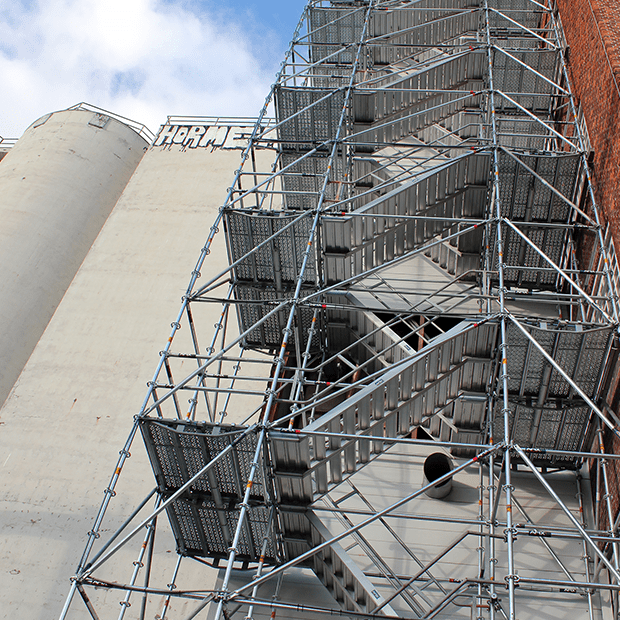A Comprehensive Guide to the Important Features of Scaffolding in Modern Construction
The landscape of contemporary building and construction increasingly depends on efficient scaffolding systems that prioritize performance, advancement, and security. As projects expand in complexity, recognizing the crucial functions of scaffolding ends up being critical for guaranteeing employee security and maximizing job timelines. This overview checks out numerous sorts of scaffolding, highlights essential safety and security functions, and examines product advancements that add to efficiency and sustainability. Nevertheless, the ramifications of these components extend much past plain building methods, motivating a more detailed consider how they influence overall job success and worker wellness.
Types of Scaffolding
Although scaffolding systems can differ commonly in layout and application, they typically fall under numerous distinctive classifications that accommodate various construction requirements - Scaffolding. The most common kinds include supported scaffolding, put on hold scaffolding, and rolling scaffolding
Supported scaffolding contains platforms sustained by a framework of poles, which offer a steady and raised working surface. This kind is usually utilized for jobs that require substantial elevation, such as bricklaying or outside paint.
Suspended scaffolding, conversely, is used for projects calling for accessibility to high altitudes, such as cleaning or repairing building facades. This system hangs from another framework or a roof, permitting workers to lower or raise the system as required.
Rolling scaffolding features wheels that enable simple flexibility throughout a job site. It is specifically valuable for tasks that need constant moving, such as indoor work in large rooms.
Each type of scaffolding is made with details applications in mind, making certain that building and construction tasks can be accomplished effectively and successfully. Recognizing these categories is important for selecting the ideal scaffolding system to fulfill both project demands and site problems.
Secret Security Attributes
Safety is extremely important in scaffolding systems, as the prospective risks associated with operating at heights can bring about major crashes if not properly handled. Key safety features are important to make certain the wellness of workers and the stability of the building website.
First and primary, guardrails are crucial. These obstacles provide a physical guard against falls, significantly minimizing the risk of major injuries. Additionally, toe boards are usually made use of to stop devices and materials from falling off the scaffold, shielding employees below.
An additional important component is making use of non-slip surface areas on platforms. This attribute enhances grip, especially in damaging weather, thus minimizing the probability of slips and falls. Moreover, accessibility ladders should be securely positioned to facilitate risk-free entrance and departure from the scaffold.
Routine examinations and maintenance of scaffolding systems are also essential. These assessments make sure that all elements are in good problem and operating appropriately, attending to any wear or damage immediately.
Lastly, appropriate training for all employees included in scaffolding procedures is important to guarantee that they understand security procedures and can identify possible hazards. Scaffolding. Collectively, these attributes create a safer working atmosphere and dramatically alleviate dangers related to scaffolding
Material Developments
Improvements in material science have dramatically influenced the scaffolding industry, improving both security and performance in modern building. The intro of high-strength steel and aluminum alloys has transformed conventional scaffolding systems.
In addition, ingenious composite materials, such as fiberglass-reinforced plastics, have become feasible choices. These materials are resistant to deterioration and ecological degradation, hence extending the life-span of scaffolding systems, particularly in harsh climate conditions. Using such materials adds to decrease upkeep costs and guarantees constant efficiency in time.


Style Factors To Consider
Thinking about the complexities of contemporary building jobs, effective scaffolding layout is paramount to making sure both performance and safety and security. Style considerations should incorporate numerous variables, including lots capability, height, and the particular requirements of the construction website. Each job offers distinct obstacles, requiring a flexible technique to scaffolding systems that can adapt to varying conditions.
Architectural integrity is crucial; consequently, designers need to determine the tons that the scaffolding will sustain, including employees, products, and try this tools. The choice of products plays an essential function in guaranteeing the scaffolding can hold up against these lots while continuing to be sturdy and light-weight. Furthermore, the layout has to permit very easy gain access to and egress, promoting the smooth motion of employees and products.
Safety functions, such as guardrails and non-slip surface areas, need to be included to lessen dangers of accidents. The layout needs to think about the surrounding setting, including adjacent frameworks and possible threats. By addressing these layout considerations, construction firms can improve the efficiency of scaffolding systems and advertise a safer working setting, inevitably adding to the overall success of the job.
Maintenance and Examinations
The performance of scaffolding systems prolongs beyond first style and implementation; continuous maintenance and normal examinations are crucial to guaranteeing their continued performance and safety throughout the period of a project. Regular assessments need to be performed by qualified personnel to identify any type of signs of wear, damage, or instability that might endanger the stability of the scaffolding.
Maintenance procedures need to consist of routine checks of structural elements, such as fittings, planks, and structures, guaranteeing that all components continue to be safe and secure and complimentary from rust or other wear and tear. Furthermore, the functionality of safety functions, such as guardrails and toe boards, have to be assessed to ensure conformity with safety and security laws.
Documents of all examinations and upkeep tasks is essential for responsibility and governing conformity. A systematic approach to record-keeping not only help in tracking the problem of the scaffolding but likewise gives essential evidence in case of an incident.
Inevitably, establishing a comprehensive maintenance and evaluation routine will dramatically minimize the threat of accidents and improve the total security of the building site. By focusing on these practices, construction supervisors can protect employees and support the job's honesty.

Verdict
To conclude, the important features of scaffolding in modern-day building and construction like it include a series of vital aspects, including varied types, key safety systems, product technologies, and thoughtful design factors to consider. Highlighting safety and security through guardrails and non-slip surface areas, alongside innovations in products like high-strength steel, enhances both performance and sustainability. Furthermore, regular maintenance and inspections are vital for making sure structural honesty and security on building sites, ultimately assisting in reliable task implementation and advertising the well-being of employees.
The landscape of modern-day building and construction increasingly counts on reliable scaffolding systems that focus on technology, effectiveness, and security.Developments in material science have pop over to these guys significantly influenced the scaffolding industry, boosting both security and effectiveness in modern building and construction. On the whole, these product developments not only enhance the performance and safety of scaffolding systems however likewise line up with the sector's push in the direction of sustainability, as lots of modern materials are created to be much more ecologically pleasant.
Taking into consideration the complexities of contemporary building and construction tasks, reliable scaffolding design is paramount to guaranteeing both capability and safety.In verdict, the important attributes of scaffolding in modern building encompass a variety of important elements, consisting of diverse kinds, essential safety and security mechanisms, material developments, and thoughtful layout considerations.